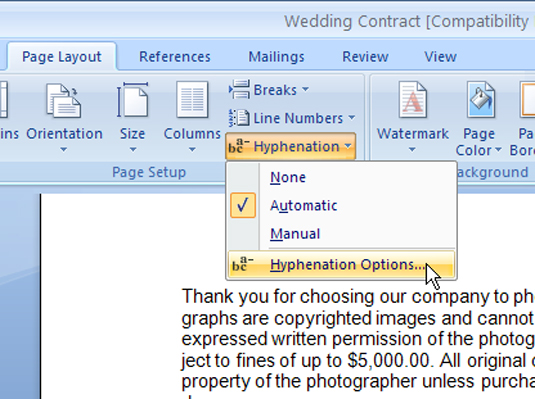
These symbols won’t print they just help you see what you’re working with. All sorts of stuff will appear on your page, like paragraph marks, a dot for each space, and, yes, nonbreaking spaces and optional hyphens. The quickest way in Word 2011 is to click the “Show all nonprinting characters” button on the standard Word toolbar (it looks like a paragraph symbol). The hyphen only shows up when it’s needed, and the nonbreaking space never appears at all.

The nonbreaking space and optional hyphen are “invisible” characters. To add an optional hyphen in Word for Mac, put your cursor at the spot in the word where you want a hyphen, then hold the Command key as you press the hyphen key. Word will know that if, and only if, the word “splitting” occurs at a line break, it should add a hyphen where you indicated, then drop the rest of the word to the next line. But maybe you want to split a word up by hyphenating it. Usually, at the end of a line, Word will take the next word you type and move it down one line. Optional hyphens are similar to nonbreaking spaces, in that they control how Word handles things at a line break. To add a nonbreaking space in Word for Mac, put your cursor after the first word in the phrase you want to keep together, then hold the option key as you press the space bar. Then, Word will consider the words as one long word, always to be kept on the same line of text.
WORD FOR MAC 2011 SOFT HYPHEN UPDATE
Word doesn’t know that “Carlos Juan” and “del Fuego” have a relationship to each other, but if you prefer that those words stay together, add a nonbreaking space between each one. In the same document, Microsoft told those running the newer Office 2016 for Mac that they must update its applications. I want to introduce you to my friend, Carlos Juan Just use your best judgment.A quick tip today about nonbreaking spaces and optional hyphens in Microsoft Word.Ī nonbreaking space tells Word not to put a line break between a given two words.įor example, the following example looks a little funny, because the person’s name is split over a line break: Otherwise your previous line will have a lot of extra space between/within words, which may look a little awkward. If you’re controlling the line wrap of your paragraphs using either of these techniques, and your paragraphs are full-justified (meaning they have straight edges at the left and right margins), you’ll want to be careful you’re not wrapping too long a word to the next line. They’re just the way that the Show/Hide feature represents the different space characters. None of those little dots, solid or open, ever prints. The non-breaking one is an open circle, while the regular space is a dot.īut don’t worry. Notice how, when Show/Hide is turned on, the on-screen representation of a non-breaking space is different than the regular space character. To do this, you need to insert a non-breaking space between the words “unduly” and “burdensome.” Just delete the existing regular space between the words and insert a non-breaking space by using CTRL-SHIFT-SPACE. The first character is a hyphen, if you click it. Type 'soft hyphen' into the search box in the title area to the right. In the menu bar click on Show Character Viewer. What if you wanted to keep the words “unduly burdensome” on the same line, but the line broke naturally after “unduly”? you can add any character to any program (almost) on a Mac just go to System Preferences -> Keyboard and select 'Show Keyboard & Character Viewers in menu bar. The new “soft” hyphen will look the same as the old one, but it’ll never allow a line break in the middle ever again. To put one of those babies in, just delete the hyphen you already have and, with your cursor still in place between the words you want hyphenated, press CTRL-SHIFT-HYPHEN (yes, that’s all at the same time, so you’ll need a little coordination to pull this off). To prevent that from happening, you need a different kind of hyphen than the standard one you see on the keyboard right next to the number zero. In some instances (and for some people), this really isn’t a problem. The problem with putting a hyphenated word at the end of a line is that the line could break right at the hyphen character. These days? Not so much.īut you can still stop awkward breaks - hyphenated words or other groups of words that need to appear together on a single line - with a quick three-key combination. But at least then you had total control over where the line break was. Yes, it was a pain in the neck compared to typing on a word processor.

Soft hyphens can be represented by the HTML entity or the Unicode. Put another way, the character says ‘hyphenate here if you need to’.

Thus a soft hyphen is a hyphen which is only displayed when a word is split across two lines. Please.) Every time you heard that little ding when you approached the right-hand margin, you knew you needed to reach up, hit that bar over on the left side, and return the platen to the left margin to start a new line. Soft hyphens enable you to manually insert hyphenation points in words, predating the hyphenate CSS property.

Remember typewriters? (Those of you too young to remember those, just skip this part.


 0 kommentar(er)
0 kommentar(er)
